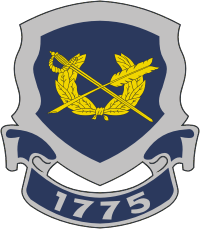The Judge Advocate General's Legal Center and School
38°3′15″N 78°30′28″W / 38.05417°N 78.50778°W
 | |
| Established | 1 February 1942 |
|---|---|
| Location | , , United States |
| Campus | Urban |
| Website | tjaglcs.army.mil |
The Judge Advocate General's Legal Center and School, also known as The JAG School or TJAGLCS, is a graduate-level division
History
Despite a long record of service by

In August 1951, the Army accepted an offer from the University of Virginia to move the school there permanently.[3] The Seventh Judge Advocate Officer Basic Course and First Judge Advocate Officer Advanced Course began in the fall of 1951.[3] The University of Virginia was selected due to its proximity to Washington, D.C., and because it had the largest law library in the South at the time.[4] The Judge Advocate General's School was initially located in Clark Hall, then behind Clark Hall in what is now called Kerchof Hall.[5] In 1975, the JAG School relocated with the UVA's Law School to the university's North Grounds. Due to the close relationship between the Law School and JAG School, JAG students often share courses with UVA law students, and multiple UVA law professors serve as Army JAG officers.[6]
The building, and the adjacent law school building, were designed by Hugh Stubbins & Associates with Rawlings, Wilson, and Fraher.[7] An addition to the building, designed by Bohlin, Powell, Larkin, and Cywinski in collaboration with Johnson, Craven, and Gibson, was completed in 1991.[7]
Leadership
The Legal Center and School (LCS) is led by a
Prior to entry into the JAG School, all Army judge advocates must have graduated from an ABA-accredited law school and be admitted to practice law by the highest court of a state or federal district. While some judge advocates have prior enlisted or commissioned experience, most are direct commissioned and have no prior military training or experience. The JAG School is generally considered the most exclusive graduate service academy within the U.S. Federal Government. Acceptance into the Army JAG Corps and subsequent JAG School is considered "highly selective" with an acceptance rate ranging between 4-7%. In 2017, the Army JAG Corps accepted 200 out of 4,000 applicants.[9] The JAG School has a long history of supplying attorneys into the military and federal government roles, particularly the federal judiciary.
The initial entry training into the JAG Corps is composed of two phases, first a 6-week Direct Commission Course (DCC) at Fort Moore, Georgia followed by military legal training at the JAG School.
Master of Laws (LL.M.)
The Judge Advocate Officer Graduate Course is the school's "flagship" course.
The Graduate Course covers a full resident academic year from mid-August to mid-May. The fall and spring semesters include core classes required of all students. In the second quarter of the fall semester and in the spring semester, students select from approximately fifty electives offered by the school's four academic departments:
Other programs
In addition to the Judge Advocate Officer Graduate Course that leads to the
Notable alumni
See also
- Naval Justice School
- Air Force Judge Advocate General's School
References
- ^ The JAG School lies entirely within the City of Charlottesville—unlike the adjacent University of Virginia School of Law, most of which lies within Albemarle County, which encloses but does not include the City of Charlottesville. For more details, see the University's official "Building Category Map", which clearly shows the city-county boundary and the JAG School within the city, downloadable here [1].
- ^ a b c d "Graduate Course (LL.M. Program)". Jagcnet.army.mil. Retrieved 26 May 2011.
- ^ a b c d "History of The Judge Advocate General's Legal Center & School". Jagcnet.army.mil. 14 July 2003. Retrieved 26 May 2011.
- ^ McNally, Katie. "A Shared Calling: U.S. Army JAG Corps Forges Strong Connection With UVA Law". www.law.virginia.edu. University of Virginia School of Law.
- ^ "Legal Center and School Photographs". Jagcnet.army.mil. Retrieved 26 May 2011.
- ^ McNally, Katie. "A Shared Calling: U.S. Army JAG Corps Forges Strong Connection with UVA Law". \law.virginia.edu. University of Virginia School of Law.
- ^ a b "North Grounds, Web Map, U.Va". Virginia.edu. 15 April 2010. Retrieved 26 May 2011.
- ^ The Institute of Heraldry, "Judge Advocate General's Legal Center and School"
- ^ "Law Students Accepted into the Military JAG Corps Program". uwyo.edu. University of Wyoming.
- ^ "United States Code: Title 10,4315. The Judge Advocate General's School: master of laws in military law, LII / Legal Information Institute". Law.cornell.edu. 18 May 2011. Retrieved 26 May 2011.
- ^ "Courses". Jagcnet.army.mil. Retrieved 26 May 2011.
- ^ "NCOA". Jagcnet.army.mil. Retrieved 26 May 2011.

